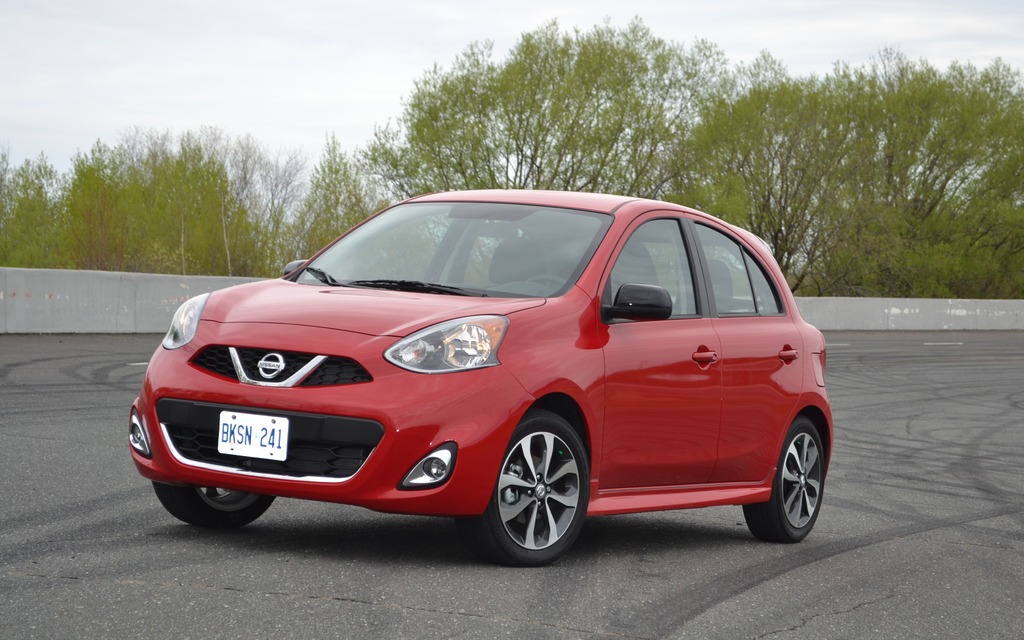2015 Nissan Micra: A New Car for Under $10,000

| Strong points |
|
|---|---|
| Weak points |
|
Back in the day, when neither the price of gas nor a vehicle’s fuel consumption were big causes for concern, Nissan offered the Micra, a sub-compact whose success was predicated primarily on a very attractive base price. Introduced in Canada in 1984 then taken off the market in 1992, the Micra is back this year with the 4th generation version. Interestingly, it’s sold in over 160 countries, but still not in the United States. The Micra’s mission is to stand out thanks to its great value—and with a base price of $9,998, it earns the title of the least expensive car in Canada.
The most perceptive of you out there will have already noticed that Nissan already has a sub-compact: the Versa. Why would they introduce a rival for the Versa, especially since the sedan was abandoned, leaving Nissan with two hatchbacks in the same segment? The answer is simple: to have a greater impact in an increasingly popular segment. So as not to cannibalize sales too much, certain differences are emphasized. For example, the Micra is the more compact and more affordable model, while the Versa, with its more generous dimensions and superior equipment, is positioned a little higher in the segment.
Familiar components
They also have several similarities. Both are built on Nissan’s V platform and use the same 1.6-litre four-cylinder engine developing 109 horsepower and 107 lbs-ft of torque. Sure, that’s less power than many other sub-compacts – it’s still more than the Mazda2’s 100 horsepower – but for the price, you can’t really hold that against it. After all, don’t forget its purpose.
In the Micra, this engine is paired factory standard with a five-speed manual transmission or a four-speed automatic. In the Versa Note, on the other hand, it comes standard only with the five-speed manual or with an optional CVT.
One rarely buys a sub-compact for the style – it’s not easy for designers to make this type of car attractive. Fortunately, the task is a little less arduous in the case of hatchback versions. Although assembled in Mexico, there’s a distinctive European influence in Micra’s lines. The front end, with its oh-so-Nissan V-shaped grille, is the best part. The SR version is the most posh, not to mention a little more dynamic, thanks to its 16-inch rims. The Micra sure has come a long way from the 12-inch wheels it used to have. The 2015 Micra’s tail end is a tad less eye-catching. Nissan tried to create the impression of width by using very wide lights that extend even beyond the body, but it’s reminiscent of the Chevrolet Spark. They also thought to offer some accessories to help customize it and for a few hundred dollars more, the three accessories packages are full value.
What’s the trade-off?
On board, simplicity is the name of the game, especially in the Micra S base version. Manual windows, locks and mirrors, barebones steering wheel and no air conditioning, are the trade-off for getting the car for under $10,000. Undoubtedly the most attractive, the Micra SV Plus adds some additional equipment that today would be considered “essential.”
As for the rest, the ergonomics and quality of the finish are flawless. This car doesn’t seem cheap at all. Of course, with its ultra compact size, it isn’t the roomiest car you’ll ever see. Sharing the space between the front and rear passengers is going to take a certain amount of compromise. Thanks to its hatch and deep trunk, the Micra ends up being rather practical just the same. It also features 60/40 folding rear seats.
Don’t waste your time looking for the Nismo logo on the car – it isn’t there. You’ll have to settle for the 109 horses developed by the 1.6-litre four-cylinder engine. You can’t expect great performance and you’ll have to judge your distances properly before committing to passing another car. Fortunately, the car’s reduced weight helps compensate for its lack of power, to a certain extent. More power would be nice, but it makes the most of what it has. Moreover, the model’s most important numbers deal with its fuel consumption: 8.6 L/100 km in town and 6.6 highway, results based on new five-cycle tests. As for the choice of transmission, the manual does quite a good job, helping to use the available power a little better. Although it has only four speeds, the automatic also turns out to be interesting and very efficient.
At the wheel, you’ll like the Micra’s compact format that makes it very pleasant to drive in town. It weaves in and out at will, while its reduced turning radius helps it turn on a dime. Its power steering offers a good sense of control and adds a sufficient dose of assistance should the need arise. The engineers also reinforced and calibrated the suspension for our market. It’s a little more firm and the roll is well controlled thanks to the addition of front and rear stabilizer bars.
The Micra will undoubtedly be able to attract buyers. It is ideal for those who want to peace of mind when buying a new car and want to save their money for other expenses.











